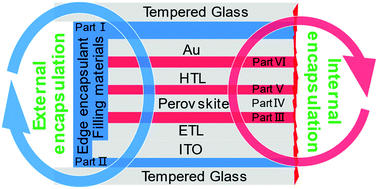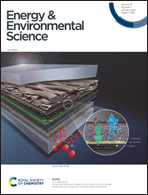Development of encapsulation strategies towards the commercialization of perovskite solar cells
Abstract
After a decade of research and development on perovskite solar cells (PSCs), the achievements targeting device stability have fallen far behind the progress made in the photoelectric conversion efficiency, which is a major obstacle in their commercialization. Although an in-depth understanding of the origin of the intrinsic and extrinsic degradation mechanisms is being rapidly acquired for these materials, the device architecture and module, together with synthetic strategies developed to improve the stability of the functional layers within the device (to inhibit phase and crystal structure transition, ion migration, morphology degradation, and surface and bulk chemical reactions), a consensus is forming that systematic encapsulation is indispensable in the device and module architecture to effectively resist harsh outdoor ageing stressors. This review, by focusing on the fundamental and technological development in the encapsulation studies of PSCs, discusses the role of encapsulation in preventing moisture and oxygen intrusion, which relies mainly on the selection of encapsulation materials, optimization of the encapsulation architecture and a more broadened sense of encapsulation to avoid the leakage of lead and improve the intrinsic stabilities of various materials in the device. Therefore, this review firstly summarizes the current state-of-the-art encapsulation approaches in various optoelectronic devices (light-emitting diodes, organic photovoltaic cells, and silicon solar cells) for their possible implications on PSCs. Then, targeting the moisture and oxygen stability, photostability, thermal stability, damp-heat stability, and thermal cycling stability, this review highlights the impact of encapsulation on these stabilities specifically. Furthermore, the authors advocate the establishment of standard and consistent procedures for the assessment of encapsulation materials and the stability of encapsulated devices for a more quantificational investigation and comparison. Finally, the current encapsulation materials are summarized for diverse techniques, developing a systematic concept of encapsulation, namely internal encapsulation, such as grain boundary encapsulation, surface and interface encapsulation, and device-level external encapsulation. This review thus offers an outlook on future material design, which may hopefully inspire future development of encapsulation technologies for PSCs.



 Please wait while we load your content...
Please wait while we load your content...